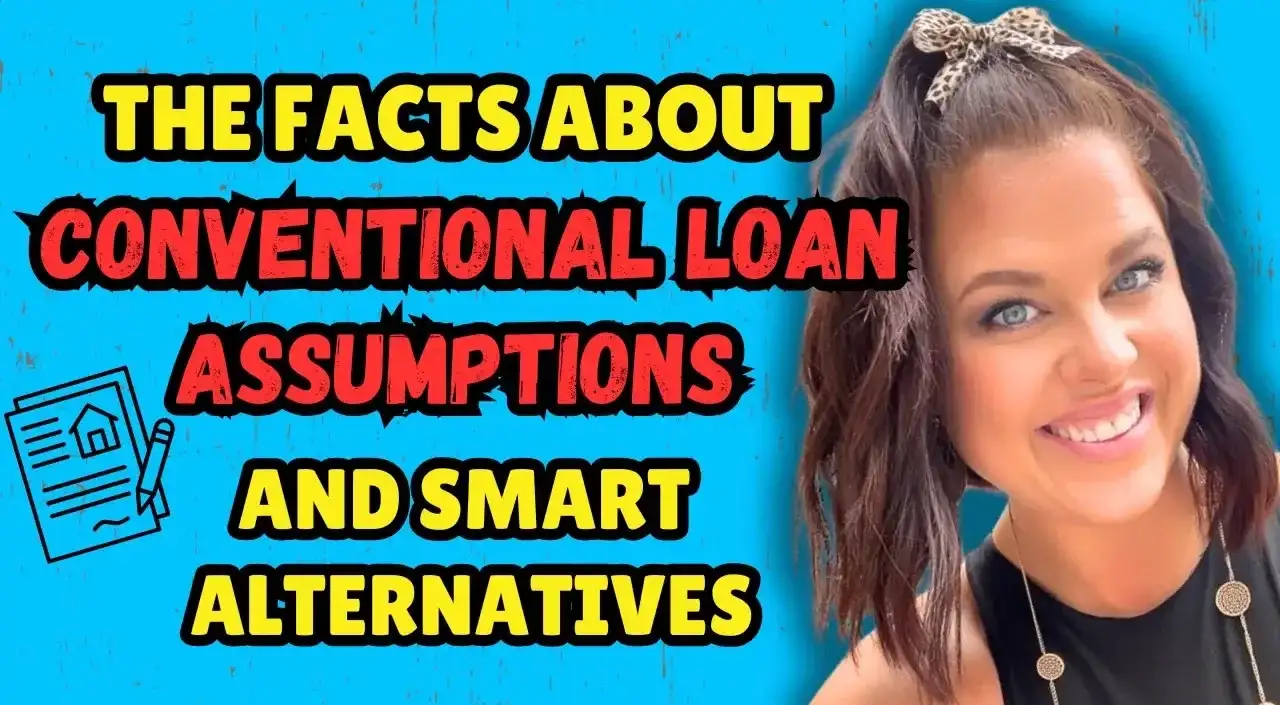Most Conventional Loans Aren’t Assumable. What To Do Instead

Most conventional loans aren’t assumable, but buyers and sellers can use alternatives like closing cost credits, seller financing, or second mortgages to reduce borrowing costs. Exploring these options can help buyers secure lower payments while making a seller’s home more attractive.
Mortgage rates have more than doubled since 2021. Homebuyers face much larger monthly payments than they would have just a couple of years ago. But current homeowners locked into a low rate may have a leg up on the competition if they choose to sell.
That's because buyers can assume some existing mortgages, giving them a drastically lower rate than is available today. This loan assumption works well for the buyer. It also makes the seller's property more desirable than comparable listings.
Are Conventional Loans Assumable?
Unfortunately, most conventional loans are not assumable. There are, however, a few exceptions to this rule, which we'll cover at the end. But are conventional loans assumable? By and large, the answer will be no in most situations.
But if you're a seller with a conventional loan or a buyer hoping to reduce interest payments by assuming an existing mortgage, you still have some options. There are a number of alternative strategies that can help you achieve the same results.
For Sellers
If you currently have a low-interest-rate loan, offering buyers the option to assume your mortgage can be a significant advantage. You might even command a higher sales price as your assumable loan could provide the buyer with significant monthly savings.
But while this is possible with FHA, VA, and USDA mortgages, most conventional loans do not allow for assumption. A couple of alternative strategies for sellers with conventional loans include:
Closing Cost Credits
Offering a closing cost credit is the simplest way to help buyers reduce their interest rates. You don't even have to come out of pocket and write a check. Instead, a portion of the proceeds from the sale are credited back to the buyer at closing. They then use these funds to purchase mortgage discount points and decrease their rate.
For example, someone purchasing your home with a $350,000 mortgage could purchase three discount points reducing their rate by about 0.75% and cutting their payment by $177 per month.
The buyer's financing limits how much closing cost credit a seller can provide. With conventional loans, the amount ranges from 2-9% and depends on the buyer's down payment. Credits can't be for more than the total closing costs. And they cannot be applied to the down payment or provide cash back at closing.
Seller Financing
Some sellers with a low-interest-rate conventional loan will offer a wrap-around to buyers. This is when the seller:
Provides financing for the purchase of the home
Receives monthly payments from the buyer
Makes the standard monthly payment on their original loan
Pockets the proceeds, which includes extra profit from the spread between the original interest rate and the higher rate they charge the buyer
This practice is not recommended because it can put the existing mortgage into default if it has a due-on-sale clause, which most conventional loans do. The holder of the original mortgage may choose to enforce the due-on-sale clause. The seller would have to pay off the remainder of the mortgage or have the property go into foreclosure.
The risk is not worth it for most people, particularly those who can’t pay off the entire balance if the loan is called. The better idea is to use sale proceeds to pay off the existing conventional loan and provide seller financing from there. Not all home sales have this much available equity, especially if the seller plans to buy another home. But seller financing without paying off a loan with a due-on-sale clause is too big a risk.
Another alternative is for the seller to agree to finance part of the buyer's purchase via a second mortgage seller carryback. These owner-carried second mortgages can help the buyer qualify for a smaller loan at current rates, with the seller offering below-market rates on the second mortgage. Conventional guidelines allow sellers to provide loans up to 2% below standard second mortgage rates.
For Buyers:
Purchasing a home has gotten far more expensive over the past few years. Not only because of rising home values but also spiking interest rates. Assuming a low-interest-rate mortgage can drastically cut your monthly payment compared to obtaining a new loan at current rates.
However, not all mortgages are assumable; unfortunately, most conventional loans are not. Luckily, there are a few alternative options that you can consider instead.
Find a Seller With an FHA Loan (Or Other Government-Backed Mortgage)
Conventional mortgages are not generally assumable. But in most cases, government-backed loans are. You can usually assume a seller's FHA, VA, or USDA mortgage. For most buyers, an assumable FHA loan would be the top pick, as VA and USDA loans have more stringent requirements.
Assuming a USDA loan also readjusts the payments to reflect current interest rates in most cases. This defeats much of the purpose of assuming a low-interest-rate loan. This option does, however, still offer the benefit of reduced closing costs.
One thing worth noting is that anyone can assume VA loans – even buyers who haven't served and aren't otherwise qualified for a VA certificate of eligibility. However, most owners won’t agree to this, since it ties up their VA loan entitlement so that they can’t use a VA loan again until the loan is paid off.
Assuming a VA loan incurs a 0.5% funding fee.
Closing Cost Credits
The most straightforward alternative to get below-market rates when the seller has a non-assumable loan is to ask for a closing cost credit. This credit can then be used to buy mortgage discount points.
These points generally cost 1% of the loan amount and reduce the mortgage's interest rate by 0.25%. Lenders usually allow buyers to purchase up to four discount points, equating to a roughly 1% rate reduction.
For Example:
A buyer taking out a $350,000 30-year fixed-rate loan asks the seller for $10,500 in closing cost credits. This would allow the buyer to purchase three mortgage discount points, reducing their interest rate by around 0.75%.
Standard Purchase | With Closing Cost Credit | |
Loan Amount | $350,000 | $350,000 |
Base Interest Rate* | 7.5% | 7.5% |
Closing Cost Credit | n/a | $10,500 |
Mortgage Discount Points | n/a | 3 |
Final Interest Rate | 7.5% | 6.75% |
Monthly Payment (PITI) | $2,899 | $2,722 |
*Estimated with a 7.5% interest rate. Available rates may vary.
Monthly payment excludes PMI and is estimated with the MRC conventional loan calculator.
In this scenario, obtaining seller credit of $10,500 to buy down the borrower's interest rate would cut payments by $177 monthly. Over the life of the loan, the buyer would save more than $60,000 in interest.
Seller Financing
Although it's far less common than in years past, rising interest rates have made it practical for some property owners to offer seller financing. Seller financing can come in several forms, including traditional owner financing, wrap-around loans, and seller carrybacks.
Traditional owner financing is when the seller owns the property outright and is willing to finance the entire loan amount for the buyer. This situation offers the buyer and seller the most freedom to negotiate mutually beneficial interest rates and loan terms.
A wrap-around loan occurs when a property owner has an existing mortgage with a balance less than the home’s market value. The seller would then finance the buyer’s loan, using part of the monthly payment to pay their existing mortgage while keeping the remainder as proceeds.
Buyers need to use extra caution in this situation to ensure the seller's original mortgage allows for a wrap-around transaction. If not, the original lender may choose to foreclose on the home, with the buyer having very little recourse.
Seller carrybacks are when the property owner agrees to hold a secondary mortgage, allowing the buyer to take out a reduced loan at current market rates. Lending guidelines for these owner-carried second mortgages vary, but conventional loans allow sellers to charge 2% less than standard interest rates
Certain Situations Where Conventional Loans ARE Assumable
While they will not apply to the vast majority of transactions, there are certain situations where conventional loans are indeed assumable.
The most noteworthy instance is in the event of inheritance or divorce. The Garn-St. Germain Act of 1982 made it simpler for individuals to assume a conventional loan when inheriting a mortgaged property or when awarded sole ownership as part of divorce proceedings.
Though far less common than fixed-rate loans, conventional adjustable-rate mortgages (ARMs) are usually assumable. They can't, however, be assumed in their initial fixed-rate period or after being permanently converted into a fixed-rate mortgage. Plus, assumed ARMs aren't eligible to be converted to a fixed rate. These restrictions leave little incentive for buyers to assume an ARM, especially if interest rates continue to rise.
Finding the Right Conventional Loan Assumption Alternative
In most cases, conventional loans are not assumable. While government-backed loans like FHA mortgages are, buyers limiting their home search to properties with assumable FHA loans will find fewer options to choose from.
Instead, some of the best alternatives include asking sellers to provide closing credits to buy down your interest rate, carry the purchase loan at favorable interest rates, or offer a second mortgage to reduce the amount financed at market rates.
If you want an accurate idea of the loan amount and interest rates you qualify for, as well as what kind of monthly payments you can expect, contact a lending professional. These mortgage experts can guide you towards alternatives to assuming a conventional loan that can help you reach the same end homebuying goals.





